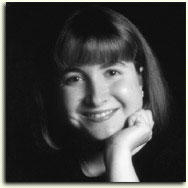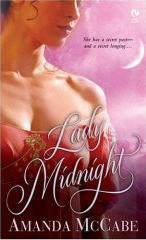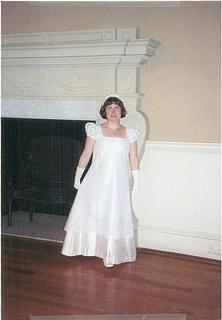 Amanda McCabe has written 11 books and 2 novellas for Signet Regency, with more on the way! She’s been a finalist for the RITA, RT’s Reviewer’s Choice Award, and the Daphne DuMaurier Award, the winner of the Holt Medallion, National Reader’s Choice Award, and the Bookseller’s Best.
Amanda McCabe has written 11 books and 2 novellas for Signet Regency, with more on the way! She’s been a finalist for the RITA, RT’s Reviewer’s Choice Award, and the Daphne DuMaurier Award, the winner of the Holt Medallion, National Reader’s Choice Award, and the Bookseller’s Best.
When not reading or writing romance, she loves doing needlework, taking dance lessons in ballet and flamenco, and digging through antique stores in search of new treasures. She lives in Oklahoma with two cats and a Pug dog. Learn more at ammandamccabe.tripod.com

Praise for LADY MIDNIGHT!
“LADY MIDNIGHT will enchant and enrapture readers with its great depth of character—enhanced by Kate’s conversations with her mother—a tantalizing plot with wonderful gothic overtones and a daring hero.” — Kathe Robin, for Romantic Times Bookclub
4 1/2 Stars, TOP PICK! Read the review
“LADY MIDNIGHT is a satisfying read for those who prefer their historicals modeled on the gothic overtones, luscious prose and extensive introspection of Charlottë Bronte’s Victorian-era novels rather than on the witty repartee of Jane Austen’s regencies.” — Mary Benn, for The Romance Reader Read the review
“…a lovely, uncomplicated, and completely believable story of two people falling in love over passion and mutual interests.” — Jeanne W, for All About Romance Read the review
The Interview
Q. How did you think of writing this particular book? Did it start with a character, a setting, or some other element?
It actually started with the opening scene! I had a vision of a woman in a ballgown washed up on a beach. How did she get there? Who was she? I had to find out the answers. That’s often the way stories evolve for me–a flash of a scene, a character, maybe sometimes a setting that screams out to be peopled!
Q. How long did it take? Was this an easy or difficult book to write?
It took longer than my trad Regencies, that’s for sure! By the time I got to page 220 and still had half the book to write, where a trad would be finished by then, I wondered what I was thinking. But it wasn’t a particularly difficult book to write. It was one of those stories where the characters just take off in the direction they want to go and I follow them. Unfortunately, it meant that a couple of the secondary characters started taking over toward the end of the book, when they weren’t meant to do that at all. Very naughty of those characters!
Q. Tell me more about your characters. What or who inspired them?
Well, the heroine, Kate, arose from that first scene. It soon became clear that she was Italian, the daughter of a courtesan, who wanted something different for her own life than what her mother had. She seizes the chance to make a new start the only way she can–by becoming a different woman, a respectable governess. But she can’t quite leave the past behind, no matter how much she tries. The hero is the same, in that he did things in his past, made mistakes that he still pays for. But together they learn that amends can be made, and the future made brighter by love. This seems to be a theme that pops up often in my stories–love as redemption.
Q. Did you run across anything new and unusual while researching this book?
I had huge fun researching the lives of courtesans in the Regency period! I actually compiled quite a list of great books, if anyone is interested. I also set the story in Yorkshire, a place I never wrote about before (and only visited once, very briefly, a long time ago), but it’s a spot that can get a strong hold on imagination. It inspired a very Gothic-ish, slightly spooky atmosphere. The legend of the Semerwater lake, which plays a huge part in the book, is a true story. I first found it in “James Herriott’s Yorkshire” and then found more information on the story online.
Q. What do you think is the greatest creative risk you’ve taken in this book? How do you feel about it?
Well, writing a longer book was a risk! I was very intimidated at first. 🙂 And my heroine is not your run-of-the-mill debutante. She’s older, Italian, was raised in the demi-monde. It also appears that making the villain slightly sympathetic was risky, though I didn’t realize it at the time.
Q. Is there anything you wanted to include in the book that you (or your CPs or editor) felt was too controversial and left out?
Well, Janet asked if I considered making my heroine a real ‘ho, which was funny because in the first draft of the proposal Kate WAS a real courtesan. Her character was really more like what her mother’s became in the end. The publisher thought that might be a hard sell for my first historical, so I changed it to an almost-‘ho. But her character remained essentially unchanged. She was still wary, slightly cynical, cautious, always looking over her shoulder at the past.

I DO like foreigners, don’t I! A heroine (actually 2) from Jamaica, a hero from India, a heroine from Russia, one from Italy. Wow, I never thought about it much until now. I think I like the concept of the “outsider” coming into Regency Society. How do they see it? How do they deal with their differences? How does it affect the story that they have a slightly different viewpoint form everyone else? And how does it change the views of the character who is more the “insider”? I’m also very interested in a variety of cultures, especially Russia and India, and read so much about them I felt like I needed to use that knowledge for something.
Q. What are you working on now?
To quote the Pythons, “and now for something completely different.” I’m finishing up the first in a trilogy set in Renaissance Venice. At least the first book is set in Venice (it’s a very dark, suspenseful story with a pirate hero and a perfumer/alchemist heroine, lots of fun!), the other two are set in England, at the court of Henry VIII as he attempts to divorce Katherine of Aragon, and in the misty Balkans. I’m enjoying them very much, but I also miss the Regency. I’m hoping to go back to it when these books are done. The villain of LADY MIDNIGHT, Julian Kirkwood, has been bothering me to tell his story. 🙂

Amanda:
If given the opportunity, would you ever write a true Gothic? Your stories seem as if they have that suspenseful edge. And what other time periods are you interested in? Would you ever consider writing a contemporary?
Great interview, Amanda!
I know what you mean about the challenges of writing a longer book. I’m finding that pre-plotting longer stories is much harder than the standard length Regencies. I’m trying to adapt my process now, doing more of what Jo Beverley has called “flying in the mist” but it’s scary to work that way.
It sounds like you are more of a mist-flyer than a pre-plotter, is that true? How do you get over the fear of not knowing What Comes Next?
Elena
LOL! First, Megan’s question–I might tackle a real Gothic someday, if I could come up with something besides the cliched “heroine running along the cliff in her nightgown”, with a brooding hero, crumbling castle, spooky noises at night, creepy servants, etc. I loved those books when I was a kid. As for contemporary–I’ve tried it before, but it always comes out sounding, well, silly. Like my characters are constantly auditioning for a Jane Austen movie. But maybe that could be the plot? 🙂
Elena, I’m definitely a mist-flyer. I start out with a brief synopsis (a page or two), so I have something of an idea where I need to go, but whenever I try to do more detailed outlines or flow charts or whatever, I drive myself insane. And the story never ends up like the outline, anyway. I kind of like discovering the story as I go along. 🙂